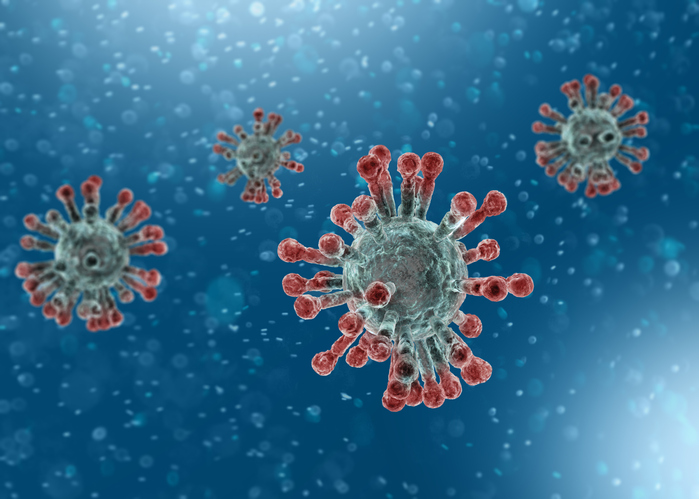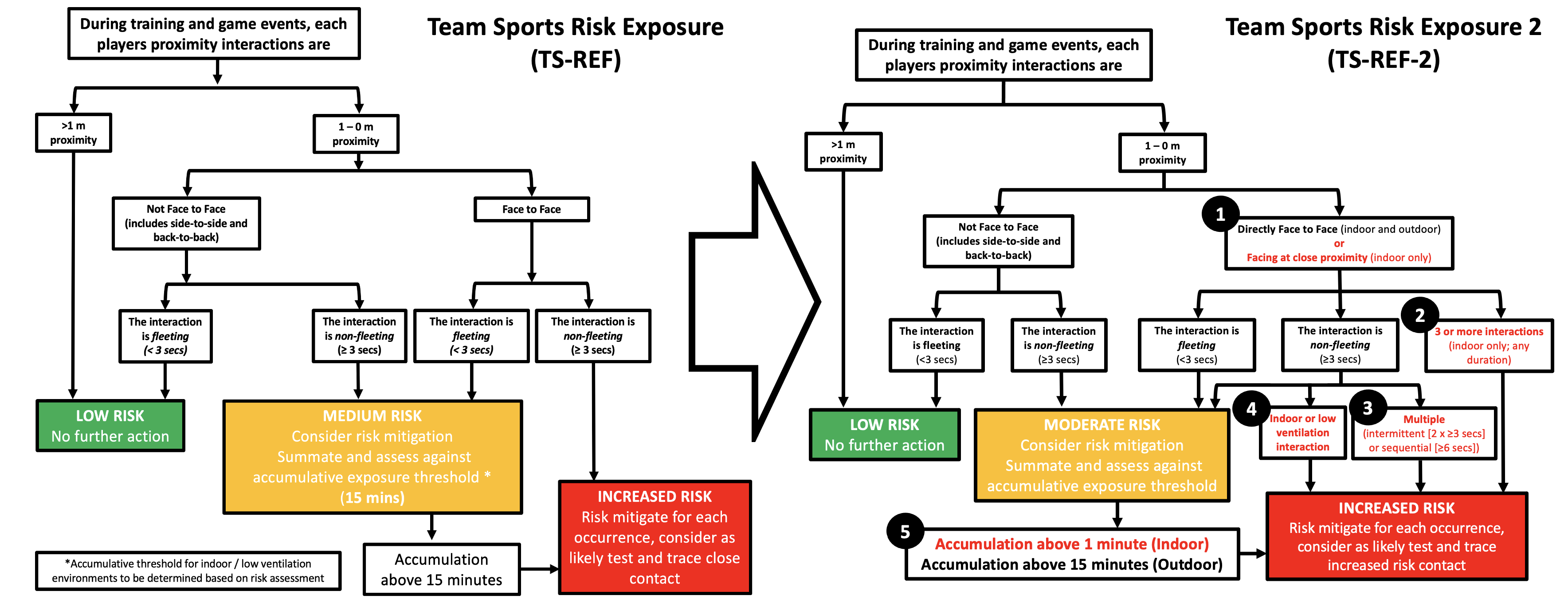The Team Sport Risk Exposure Framework-2 (TS-REF-2) to Support the Identification of Increased Risk Contacts in Sport during the COVID-19 Pandemic
During the COVID-19 pandemic professional sports have continued to run competitive leagues whilst aiming to reduce potential SARS-CoV-2 transmission. Delivering competitions becomes a challenge when matches are cancelled, postponed or forfeited due to COVID-19 outbreaks. Sports are managing this, whilst prioritising player and support staff health through the implementation of intensive risk mitigation strategies (e.g. SARS-CoV-2 screening, strict social distancing and hygiene practices, monitored social distance breaches during sporting activities), along with the identification and isolation of close or ‘increased risk’ contacts.[1]

The identification and isolation of players and staff in elite sport, should be undertaken with appropriate precision to both prevent infected individuals remaining in the environment (e.g. resulting in potential virus transmission), and preventing low-risk contacts having to isolate (e.g. potentially increasing the risk of injury when returning, in addition to the negative effect on mental health[2,3]), causing wider disruption to competitions.
The Team Sports Risk Exposure Framework (TS-REF) was proposed in July 2020, when potentially higher risk sports (e.g. rugby) were returning.[1] Since then, it has been adopted by both elite and community sports, to both determine the risk of SARS-CoV-2 transmission during specific sporting activities (e.g. rugby tackle),[1] and to identify and isolate increased risk contacts during sport.[4] The TS-REF classified increased risk contacts as player to player interactions ‘within 1 m, directly face-to-face, for 3 or more seconds’. Increased risk contacts, identified using the TS-REF were determined in rugby league, following interactions with 8 infectious players across 4 matches.[4] Increased risk contacts were monitored for 14-days during their isolation period, to determine if they tested positive for SARS-CoV-2. Of the 28 identified increased risk contacts from the matches, only 1 player subsequently tested positive for SARS-CoV-2, which was linked to an internal club outbreak. The risk of outdoor transmission appears lower than first thought,[4,5] and consequently the TS-REF may require players to isolate who are not at an increased risk of infection.
The TS-REF was designed primarily for outdoor activities, although the increased risk of transmission indoors was acknowledged.[1] Team sports engage in both indoor and outdoor training, thus the development of a framework that accounts for indoor activities is required.
Team Sport Risk Exposure Framework 2 (TS-REF-2)
The SARS-CoV-2 virus can be transmitted by both exhaled large ‘ballistic’ respiratory (>100 µm diameter), and aerosol (<100 µm diameter) droplets. Aerosol droplets are higher risk, as they rapidly evaporate to become small aerosol particles (<50 µm diameter[6]) that can be easily inhaled.[7] Indoors (e.g. spaces with poor ventilation) these smaller aerosol droplets can form clouds of aerosol particles, increasing the risk of transmission to those in close proximity. Outdoors, due to typically greater air velocities, exhaled aerosol particles are dispersed more rapidly, although this will become less pronounced at close proximities and when directly face to face. Since the design and implementation of the TS-REF, new variants of the SARS-CoV-2 virus have been identified. Whilst initially the new variants were thought to be more transmissible, this has been debated more recently,[8] with the increased number of COVID-19 cases likely due to asymptomatic transmission.[9] Therefore the TS-REF-2 has not been modified to account for the new SARS-CoV-2 variants.
To address the differing risks of indoor and outdoor transmission, an updated TS-REF is proposed; Team Sport Risk Exposure Framework 2 (TS-REF-2; Figure 1). Five additions have been made to the TS-REF (Supplementary Figure 1), to address the greater risk of transmission indoors and observed lower risk of transmission outdoors during sport.[4,5] A detailed explanation of changes are presented in Supplementary Table 1. The TS-REF-2 can be adopted by both elite and community sports, to identify individuals who are required to isolate, if identified as increased risk contacts. The TS-REF-2 can be used during training and match activities, and serve as a supplementation to broader public health definitions in other contexts (e.g. changing room, team meeting, car share).

Determining Indoor and Outdoor Activity
Whilst the TS-REF-2 proposes a framework to identify increased risk contacts, differentiating indoors and outdoors spaces in sport can be challenging. For example, consider a stadium with an enclosed roof, or temporary building with no / limited sides. The key considerations for determining an indoor or outdoor environment can be established from Supplementary Table 2, based on the volume, the presence of a roof or ceiling and air velocity characteristics. The indoor TS-REF-2 definitions should be applied when the sporting environments has two or more indoor characteristics. Additional risk factors may also be determined from Supplementary Table 2 (e.g. density of people in space, CO2 and environmental conditions).
Volume, the presence of a roof or ceiling, air velocity at low levels, density of people, CO2 and environmental conditions should be considered collectively when determining the SARS-CoV-2 transmission risk, and if the TS-REF-2 should be applied following the indoor or outdoor definition. For example, a large space may appear ‘outdoors’, yet if air movement at low level is poor (i.e., low air velocities) the formation of clouds of aerosol particles is possible, increasing the risk of transmission.
Conclusion
The TS-REF-2 considers the transmission risk of SARS-CoV-2 during indoor and outdoor activities, building on the previously adopted TS-REF.[4] Using the information provided in this article, policymakers and practitioners can determine if the activity was undertaken in an indoor or outdoor environment and then appropriately apply the TS-REF-2 to identify increased risk contacts in sport. The TS-REF-2 can be applied to training and match activities, for both professional and community sports, when implementation can be achieved with an appropriate level of precision (e.g. video footage available), to supplement broader non-sport contact tracing guidelines. This should be continually reviewed and updated, as the evidence related to the transmission risk of SARS-CoV-2 evolves. Ultimately, sports should aim to undertake as much activity as possible outdoors, given the lower SARS-CoV-2 transmission risk in comparison to indoors.
Authors and Affiliations:
Ben Jones1,2,3,4,5, Gemma Phillips1,2,6, Clive Beggs1, James Calder7,8, Matt Cross9,10, Neil Pearce11, Clint Readhead4,12, Jenifer Smith13, Keith A Stokes10,14 Simon PT Kemp 11,14
1 Carnegie Applied Rugby Research (CARR) centre, Carnegie School of Sport, Leeds Beckett University, Leeds, UK
2 England Performance Unit, The Rugby Football League, Leeds, UK
3 Leeds Rhinos Rugby League club, Leeds, UK
4 Division of Exercise Science and Sports Medicine, Department of Human Biology, Faculty of Health Sciences, the University of Cape Town and the Sports Science Institute of South Africa, Cape Town, South Africa
5 School of Science and Technology, University of New England, Armidale, NSW, Australia.
6 Hull Kingston Rovers, Hull, UK
7 Fortius Clinic, London, UK
8 Department of Bioengineering, Imperial College London, London, SW7 2AZ
9 Premiership Rugby, Twickenham, UK
10 University of Bath, Bath, UK
11 London School of Hygiene and Tropical Medicine, London, UK
12 South African Rugby Union, SARU House, South Africa
13 Public Health England, London, UK
14 Rugby Football Union, Twickenham, UK
References:
1 Jones B, Phillips G, Kemp S, et al. A Team Sport Risk Exposure Framework to Support the Return to Sport. BJSM Blog – Soc. Medias Lead. SEM Voice. 2020.https://blogs.bmj.com/bjsm/2020/07/01/a-team-sport-risk-exposure-framework-to-support-the-return-to-sport/ (accessed 9 Sep 2020).
2 Brooks SK, Webster RK, Smith LE, et al. The psychological impact of quarantine and how to reduce it: rapid review of the evidence. Lancet Lond Engl 2020;395:912–20. doi:10.1016/S0140-6736(20)30460-8
3 Mattioli AV, Ballerini Puviani M, Nasi M, et al. COVID-19 pandemic: the effects of quarantine on cardiovascular risk. Eur J Clin Nutr 2020;74:852–5. doi:10.1038/s41430-020-0646-z
4 Jones B, Phillips, G, Kemp, SPT, et al. SARS-CoV-2 transmission during rugby league matches: Do players become infected after participating with SARS-CoV-2 positive players? Br J Sports Med 2021.
5 Schumacher YO, Tabben M, Hassoun K, et al. Resuming professional football (soccer) during the COVID-19 pandemic in a country with high infection rates: a prospective cohort study. Br J Sports Med Published Online First: 13 February 2021. doi:10.1136/bjsports-2020-103724
6 Marr LC, Tang JW, Van Mullekom J, et al. Mechanistic insights into the effect of humidity on airborne influenza virus survival, transmission and incidence. J R Soc Interface 2019;16:20180298. doi:10.1098/rsif.2018.0298
7 Lindsley WG, Noti JD, Blachere FM, et al. Efficacy of Face Shields Against Cough Aerosol Droplets from a Cough Simulator. J Occup Environ Hyg 2014;11:509–18. doi:10.1080/15459624.2013.877591
8 New Strain or Brexit Stress? 2021;:m4944.https://www.bmj.com/content/371/bmj.m4944/rr-1 (accessed 27 Feb 2021).
9 Phillips A, Pearce N. Is asymptomatic transmission in young people driving the current wave of the SARS-CoV-2 pandemic? The BMJ. 2021.https://blogs.bmj.com/bmj/2021/02/15/is-asymptomatic-transmission-in-young-people-driving-the-current-wave-of-the-sars-cov-2-pandemic/ (accessed 12 Mar 2021).
*This blog has been submitted as an editorial to the journal, but in the interest of many community sports returning to action this Spring, this blog has been submitted to inform any risk exposure protocols in community sport in the meantime. The final editorial will be subject to peer-review, and so the content may change.